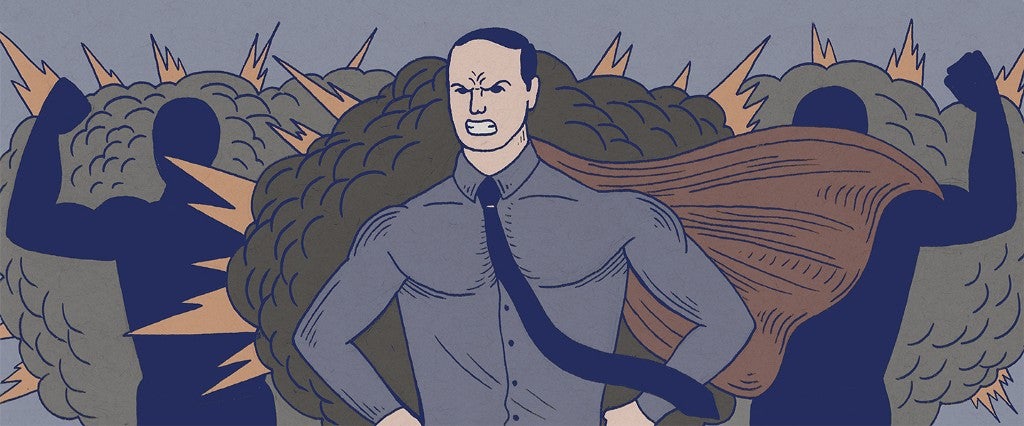The promise of “power posing” was simple: Stand like Wonder Woman for two minutes a day, and you’ll instantly feel more powerful, more accomplished, and able to achieve.
In recent years, power poses have become a standard of the productivity-maximizing business life hack literature. You could read about their benefits in the Harvard Business Review, Inc., or your preferred outlet for business listicles, and even use a discussion guide from Sheryl Sandberg’s Lean In organization to learn how to “increase your confidence… when personal presence matters most.”
Besides being very easy to pull off (you just… pose), power poses had the benefit of supposedly being based on science. In 2010, researchers found that standing for two minutes in a power pose boosted testosterone and lowered levels of cortisol (the hormone associated with feeling stressed) in your body, which made you more likely to act confidently and take calculated risks. One of those researchers, Harvard Business School professor Amy Cuddy, turned that finding into a 21-minute TED Talk that’s been viewed over 37 million times, and went on to write a bestselling book, Presence, about the power of body language.
But in the past couple of months, it’s become clear that power poses do absolutely nothing. In September, one of the other authors of the original 2010 paper, UC-Berkeley business school professor Dana Carney, published a long and detailed takedown of the concept. She calls the original data “flimsy,” says that she does “not think the effect is real,” and saddest of all, says that she regrets encouraging others to research the topic, calling further investigation “a waste of time and resources.”
In response, Cuddy went to bat for the original research, with some qualifications. Sure, she said, the whole testosterone and cortisol thing might not be true, but power poses definitely make people feel more powerful, and act more confident — we just don’t know why!
A new study released earlier this week, however, shows that even that defense doesn’t hold up. Researchers at the University of Pennsylvania set out to address one of the earlier defenses that Cuddy and her colleagues had mounted of power posing — that power poses depended on a certain social context to work, so replication was harder than it seemed — by seeing if power poses accomplished anything in the context of social dominance.
The Penn researchers’ line of thinking went like this: Humans (like their chimpanzee relatives) have been shown to naturally “power pose” when they win something — the soccer player who scores a goal runs around with his arms wide open, while the goalie who just got owned slumps his shoulders and kicks the dirt. And by and large, it’s been shown that winners of contests, be they wrestling matches, chess games or political elections, experience bumps in testosterone after their victories, while losers see their T levels dip.
So they got almost 250 male undergrads to sign up for the experiment, spit in a tube for testosterone and cortisol samples, then play tug-of-war against another participant. After three rounds of mano-a-mano rope-based competition, the overall winner was told, “Congratulations, you are the winner of this competition. Based on this measure, you are stronger than your opponent.” The loser, on the other hand, was told “I am sorry, but you are the loser of this competition. Based on this measure, you are weaker than your opponent.” Scientists aren’t very nice.
Once the social ranks were firmly established, the researchers made each participant strike a particular pose. They tried every permutation — some just stood there neutrally, some losers struck power poses, some winners struck anti-power poses, and vice versa. Then the young men answered some questions, spit in a tube to capture their post-pose hormone levels, then played a little gambling game to measure how confident they were feeling.
In the end? After all that? Bupkis. With a sample size six times larger than that of the original 2010 study, the Penn researchers found “no main effect of pose type on T, C, economic risk-taking or feelings of power.”
And in fact, the only significant finding they could come up with was that power posing might actually make things worse if you’re a loser. Given the precedent in the field, the researchers admit that it may be a false positive, but they found that the losers of the tug-of-war who were forced to hold a power pose after their loss saw a bigger dip in testosterone than their loser peers who assumed neutral or “low-power” poses.
To explain this, they looked to an old study on sparrow society from 1970s that was designed to see what would happen when low-ranking birds (analogous to our human tug-of-war losers) pretended to be high-ranking birds (like when the human losers struck a power pose, knowing full well that they were just bluffing). The scientists dyed the feathers of loser sparrows to match those of high-ranking sparrows, then watched the low-ranking “faker” sparrows get beat up and shunned by the real winners. So, the power pose researchers posit that the faker-losers’ extreme dip in T might be their bodies’ way of saying “you just got clobbered for god’s sake, don’t go and piss off the alpha males again by pretending you won.”
Or, like the earlier findings on the positive impacts of power poses, it could be meaningless. The Penn researchers wrapped up their paper by noting that in a recent review, “among 100 psychology papers, only about a third of the results were successfully replicated, and the replication rate was lower in social psychology than in cognitive psychology.”
So here’s a life hack: life hacks (and TED Talks) are usually just reheated fluff based on lame research — you can save time and increase your productivity by ignoring them.
